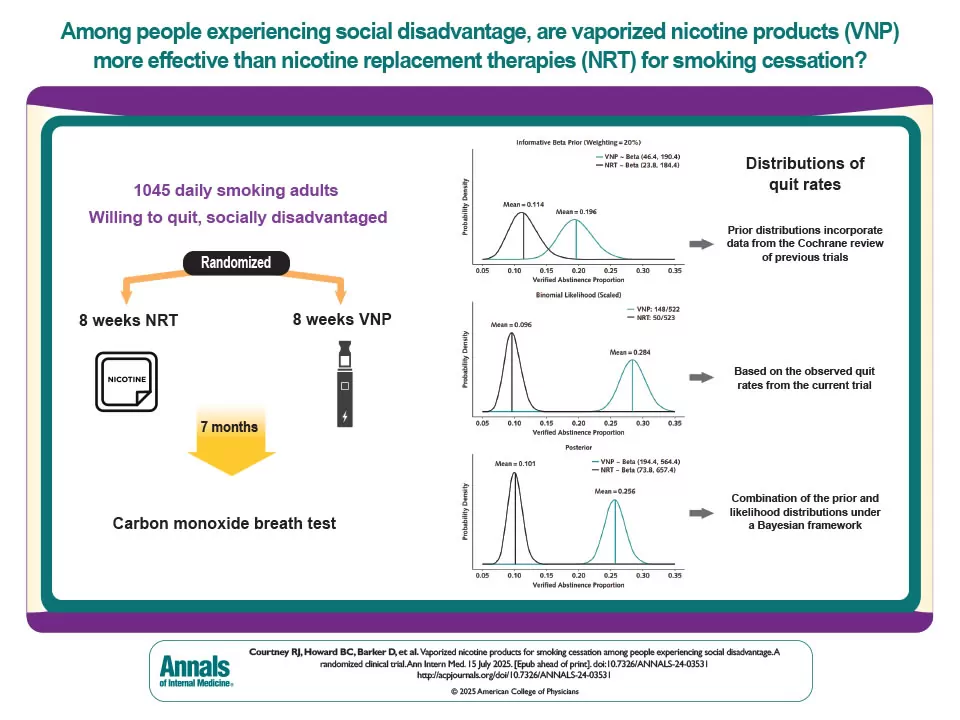Vaping Nearly 3x More Effective Than Gum to Quit Smoking
In a major clinical trial that could significantly influence public health strategies, researchers have found that vaporized nicotine products (VNPs), commonly known as vapes or e-cigarettes, are nearly three times more effective than traditional nicotine replacement therapies (NRT) like gum or lozenges at helping low-income smokers quit. The study underscores the potential of vaping as a powerful harm reduction tool, particularly for disadvantaged communities who bear a disproportionately heavy burden from smoking-related diseases.
This research provides robust, placebo-controlled evidence that adds a new dimension to the ongoing global debate about the role of e-cigarettes in public health. While concerns about youth uptake persist, these findings highlight the undeniable effectiveness of vaping for adult smokers struggling to quit.
Addressing a Critical Health Disparity
Smoking remains a leading cause of preventable illness and death worldwide, but its impact is not felt equally across society. In many countries, rates of tobacco use are significantly higher in low-income communities compared to more affluent ones. This disparity means that already vulnerable individuals are at an even greater risk of developing chronic and fatal conditions like heart disease, stroke, and various cancers. Factors such as limited access to healthcare, higher stress levels, and social environments where smoking is more prevalent can make quitting particularly challenging for this demographic. Traditional NRTs, while helpful for some, have often shown limited success in these communities. This study sought to determine if vaping could offer a more effective pathway to quitting for this specific group.
The Landmark Trial: Vapes vs. Traditional NRT
The large randomized controlled trial, led by scientists from the National Drug and Alcohol Research Centre at UNSW Sydney and published in the prestigious Annals of Internal Medicine, provided a direct comparison between vaping and traditional NRT. The study involved 1,045 adults in New South Wales, Australia, who all smoked daily, received government pensions or other forms of public assistance, and were motivated to try quitting within two weeks of enrolling.
The participants were randomly assigned to one of two groups:
- The NRT Group: This group received a traditional nicotine replacement therapy of their choice, either nicotine gum or lozenges.
- The VNP (Vaping) Group: This group received vaporized nicotine products, including e-liquids to be used in either a tank or pod-style device. The e-liquids were available in tobacco, menthol, or fruit flavors, providing users with some choice to suit their preferences.
To ensure a supportive environment for all participants, both groups were also given behavioral support through text messages for a period of five weeks. This additional help was designed to encourage participants to stick with their quit plans and provided practical tips for managing cravings and other challenges associated with quitting.
Striking Results: Vaping’s Clear Advantage
After a six-month follow-up period, the difference in quit rates between the two groups was stark and statistically significant. The key findings were:
- In the NRT group (using gum or lozenges), 9.6% of participants had successfully remained continuously abstinent from smoking.
- In the VNP group (using e-cigarettes), that number jumped to 28.4%.
This means that participants using vapes were nearly three times as likely to successfully quit smoking compared to those using traditional nicotine replacement therapies. The research team also analyzed several subgroups based on factors like age, gender, level of nicotine dependence, and mental health status. In every single category, the vaping products outperformed NRT, suggesting that the benefits of using vaporized nicotine as a cessation tool extend across a wide range of individuals, not just a few select groups.
Lead investigators believe several factors may contribute to the higher success rate of vaping. The availability of different flavors can be crucial for helping smokers dissociate from the taste of tobacco. Furthermore, the physical and behavioral aspects of vaping – the hand-to-mouth action, the inhalation and exhalation of a visible aerosol – closely mimic the act of smoking. For many smokers, this ritualistic component provides both physical and psychological relief during the challenging quitting process, an element that NRT gum or lozenges cannot replicate.

A Potential Tool for Health Equity
The findings of this study could represent an important step forward in the effort to reduce health inequalities. People with limited incomes often suffer the most from tobacco-related diseases but frequently have the least access to effective cessation tools. The high cost of some NRT products or the difficulty in accessing consistent medical support can be significant barriers. This study provides solid evidence that by making effective and appealing harm reduction tools like regulated vapes more widely available, particularly through public health programs or subsidized initiatives, more people from disadvantaged backgrounds could have a realistic chance at quitting smoking for good.
While the public health debate around e-cigarettes continues, especially concerning the need to prevent youth use, this study adds substantial weight to the argument that they can serve as a valuable and highly effective harm reduction tool for adults who already smoke. The experts involved stress that these products are intended for adult smokers trying to quit, not for non-smokers or young people.
What Comes Next?
While these findings are highly promising, the researchers acknowledge that more work is needed. Long-term follow-up studies are essential to determine whether individuals who quit smoking using vapes remain smoke-free over many years and to better understand any potential long-term health effects of vaping itself. There are also ongoing questions about the best ways to regulate and distribute these products to maximize their benefit for adult smokers while minimizing their appeal and accessibility to youth.
Nevertheless, for many health experts and community leaders, this study offers a powerful and hopeful message. It demonstrates that when people are provided with the right tools and support, quitting smoking is possible, even when facing significant life challenges like financial hardship and high stress. As public health strategies continue to evolve, findings like these may help shape policies that support not just overall health, but also health equity. After all, the opportunity to quit smoking shouldn’t be a privilege; it should be a real possibility for everyone.
- Cambodia: Phnom Penh Bans Smoking & Vaping on “Walk Street” - August 16, 2025
- Mexico City Congress Approves Ban on Vapes & E-Cigs - August 16, 2025
- Is It Illegal to Vape or Smoke While Driving in Minnesota? - August 15, 2025









